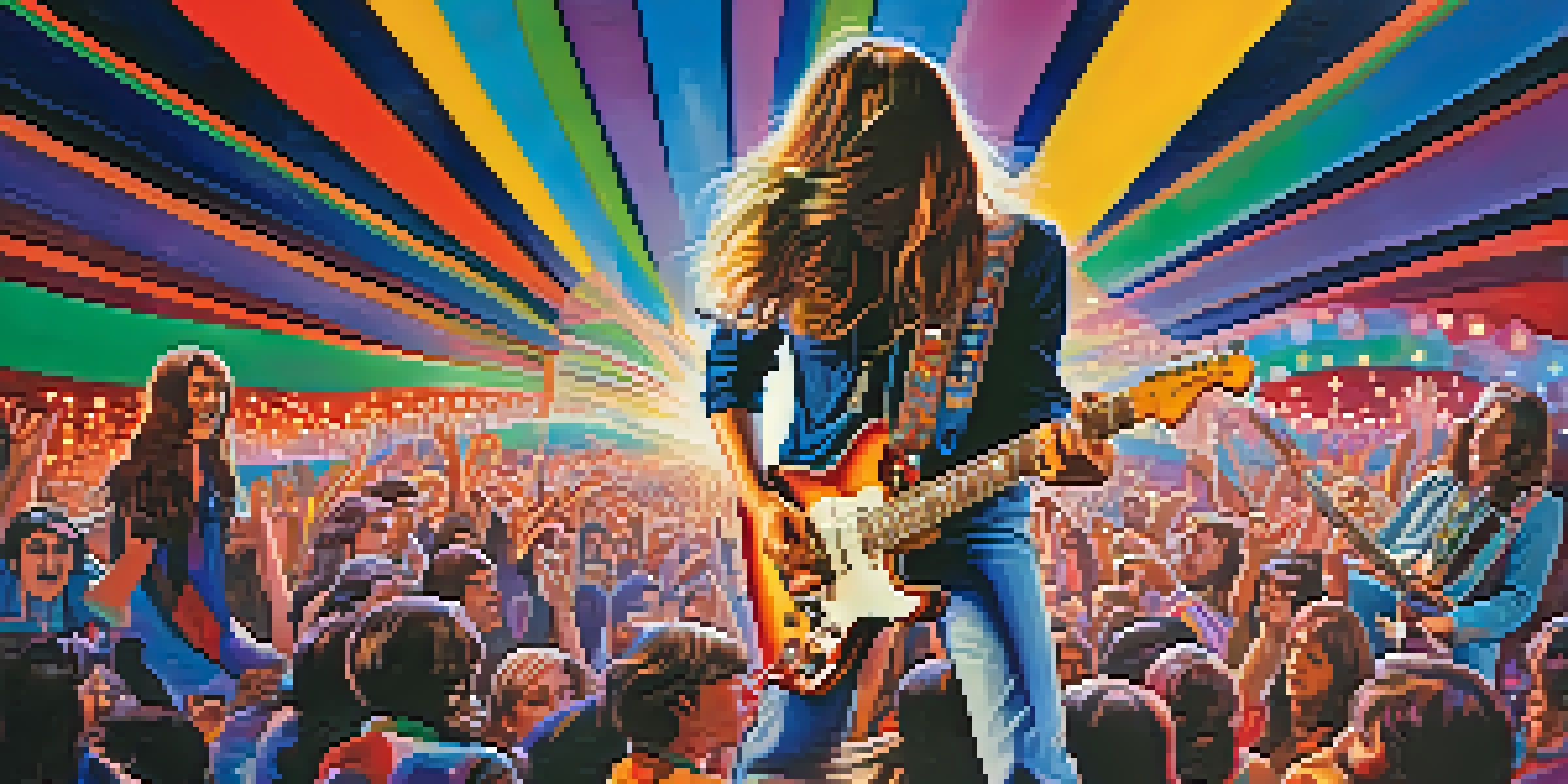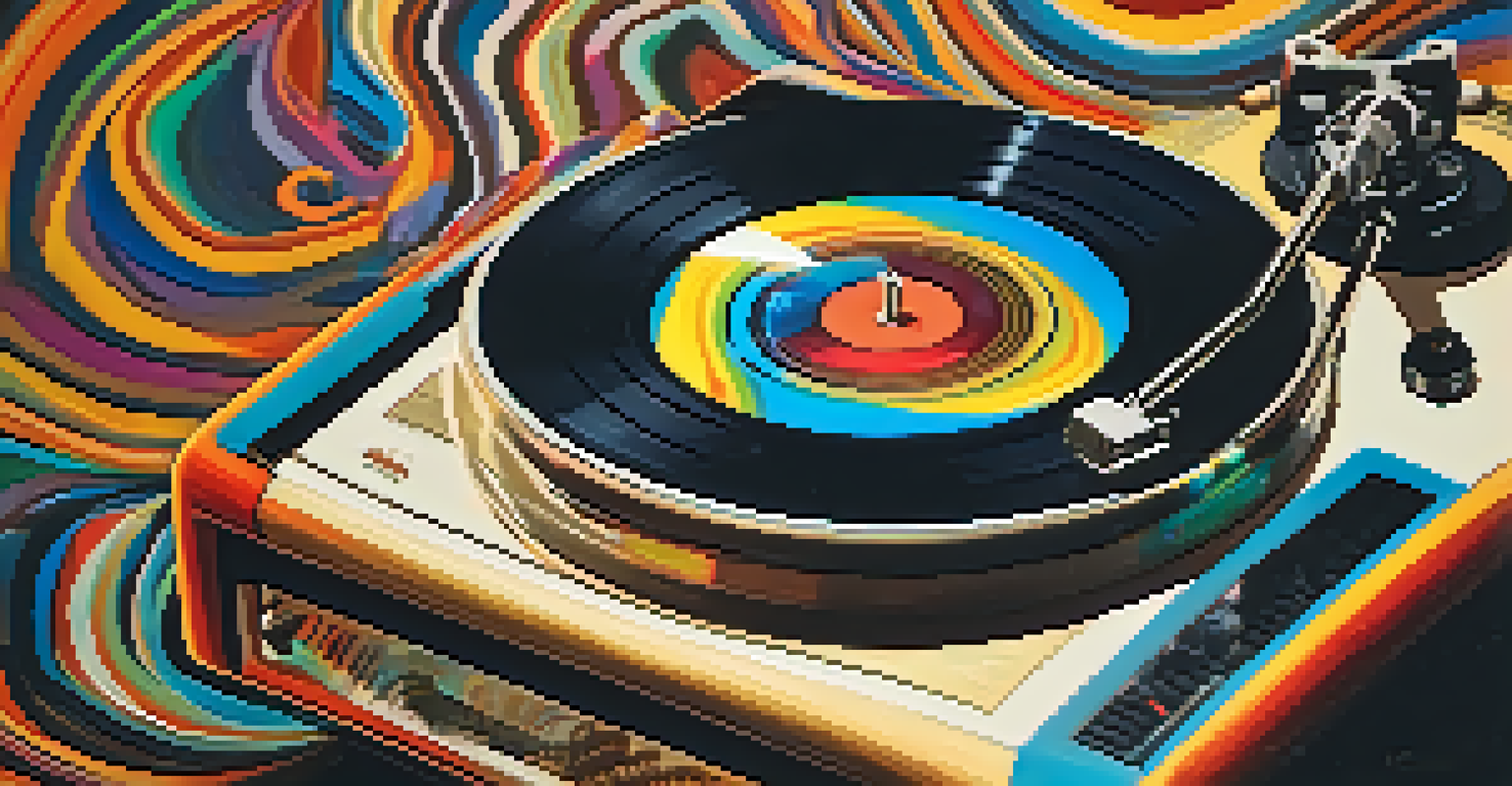Lyricism and Hallucinogens: The Doors’ Psychedelic Influence

The Doors: A Gateway to Psychedelic Rock
The Doors emerged in the 1960s, capturing the essence of a generation searching for deeper meaning. Their sound blended rock, blues, and jazz, but it was Jim Morrison's poetic lyrics that truly set them apart. The band's self-titled debut album introduced listeners to a new realm of musical exploration, one that embraced the mind-bending possibilities of psychedelia.
I believe in a long, prolonged, derangement of the senses in order to obtain the unknown.
As the counterculture movement gained momentum, The Doors became a voice for those experimenting with consciousness expansion. Their music resonated with the ideals of freedom and self-discovery, mirroring the hallucinogenic experiences many were seeking. Songs like 'Light My Fire' and 'Break On Through (To the Other Side)' exemplified this journey into the unknown.
The band's willingness to experiment with sound and lyrics laid the foundation for a genre that pushed the boundaries of traditional rock. They invited listeners to shed societal norms and explore their inner selves, establishing The Doors as pioneers of psychedelic rock.
The Influence of Hallucinogens on Lyrics
Hallucinogens played a pivotal role in shaping the lyrical landscape of The Doors' music. Jim Morrison often drew inspiration from his own experiences with substances like LSD and mescaline, which opened his mind to new creative realms. This influence is evident in songs laden with vivid imagery and surrealist themes, inviting listeners to interpret meanings beyond the surface.

For instance, in 'The End,' Morrison crafts a haunting narrative that explores existential themes, reflecting the disorienting effects of his hallucinogenic experiences. The lyrics evoke a sense of both fear and fascination, mirroring the duality of drug-induced journeys. This deep introspection became a hallmark of The Doors' style, resonating with those seeking a profound connection to their own consciousness.
Pioneers of Psychedelic Rock
The Doors blended rock, blues, and jazz with poetic lyrics, establishing themselves as key figures in the psychedelic rock movement.
Moreover, the hallucinogenic experience often blurred the lines between reality and fantasy in Morrison's writing. His ability to articulate these complex feelings through evocative lyrics allowed listeners to navigate their own psychedelic experiences, creating a shared sense of understanding and exploration.
Musical Composition and Psychedelic Elements
The Doors' unique musical composition intertwined seamlessly with their lyrical depth, creating an immersive experience. Their use of the organ, played by Ray Manzarek, added a distinct layer to their sound, evoking a sense of dreaminess that complemented Morrison's poetic verses. This combination created an atmosphere that felt both ethereal and grounded in reality.
Music is the strongest form of magic.
Tracks like 'The Crystal Ship' blend haunting melodies with introspective lyrics, painting vivid pictures that transport listeners to different realms. The interplay between Robby Krieger's guitar riffs and John Densmore's rhythmic drumming further enhanced the psychedelic feel, allowing the music to ebb and flow like the highs and lows of a hallucinogenic trip.
By incorporating various musical styles and experimental techniques, The Doors effectively captured the essence of the psychedelic experience. Their sound was not just a backdrop for Morrison's lyrics; it was an integral part of the journey, inviting listeners to lose themselves in the music and explore the depths of their own minds.
Cultural Context: The 1960s Psychedelic Movement
The Doors didn't exist in a vacuum; they were a product of the cultural upheaval of the 1960s. As the Vietnam War raged on and social norms were challenged, many sought solace in music and mind-altering substances. The psychedelic movement offered an escape, and The Doors became an emblem of this transformative period.
During this time, figures like Timothy Leary championed the use of psychedelics as a means of expanding consciousness, further intertwining music and hallucinogens. The Doors' music, with its intoxicating blend of sound and lyrics, resonated with those eager to embrace new perceptions of reality. Their concerts became gatherings for free spirits, united in their quest for enlightenment.
Influence of Hallucinogens
Jim Morrison's experiences with hallucinogens significantly shaped The Doors' lyrics, inviting listeners to explore complex themes and emotions.
As a result, The Doors' influence transcended music—they became cultural icons, embodying the rebellion and exploration of the era. Their lyrics and sound served as a soundtrack for a generation seeking to break free from conventional thinking and explore the unknown.
Legacy: The Lasting Impact of The Doors
The Doors left an indelible mark on music and culture, influencing countless artists and genres that followed. Their innovative blend of psychedelic rock and evocative lyricism paved the way for future musicians to experiment with sound and explore the depths of human experience. Even decades later, their music continues to inspire new generations of artists and listeners alike.
Songs like 'People Are Strange' and 'Riders on the Storm' showcase Morrison's ability to capture complex emotions, resonating with those who feel out of place in society. This relatability has solidified The Doors' status as timeless figures in music history, with their themes echoing in contemporary discussions about identity and existence.
Moreover, The Doors' exploration of hallucinogens and their impact on creativity has sparked ongoing conversations about the relationship between art and altered states of consciousness. Their legacy serves as a reminder of the power of music to transcend boundaries, inviting listeners to embark on their own journeys of self-discovery.
The Doors and the Art of Improvisation
Improvisation played a crucial role in The Doors' live performances, often reflecting the spontaneity associated with hallucinogenic experiences. Unlike many of their contemporaries, The Doors embraced the unexpected, allowing their music to flow organically during concerts. This fluidity created a unique atmosphere that captivated audiences and encouraged them to lose themselves in the moment.
For example, during live renditions of 'Celebration of the Lizard,' the band would extend musical sections, allowing Morrison to weave in and out of poetic verses. This improvisational style created a connection between the band and the audience, as everyone shared in the unpredictable experience. It was a communal journey into the unknown, much like the exploration of consciousness through psychedelics.
Legacy of Cultural Impact
The Doors' innovative sound and exploration of consciousness have left a lasting influence on music and culture, inspiring generations of artists.
This emphasis on improvisation not only showcased their musical prowess but also aligned with the psychedelic ethos of free expression. The Doors' ability to adapt and change during performances made each concert a unique experience, reinforcing their status as pioneers of the psychedelic rock movement.
Exploring the Symbolism in Their Lyrics
The lyrics of The Doors are often steeped in symbolism, inviting listeners to dig deeper into their meanings. Jim Morrison's fascination with mythology, spirituality, and the human experience is evident in tracks like 'The Unknown Soldier' and 'The WASP (Texas Radio and the Big Beat).' These songs carry layered meanings that resonate with the themes of consciousness exploration and existential questioning.
Morrison's use of vivid imagery and metaphor encourages listeners to interpret the lyrics through their own lens, much like the subjective experience of hallucinogens. This ambiguity allows for personal connections, making each listener's journey unique. The symbolism serves as a vehicle for introspection, prompting individuals to confront their own beliefs and emotions.

Ultimately, the symbolism in The Doors' lyrics reflects a broader quest for understanding and enlightenment. Their ability to weave complex ideas into compelling narratives invites listeners to embrace the mystery of life, reinforcing the idea that the journey of self-discovery is both personal and universal.
Conclusion: The Doors' Enduring Psychedelic Legacy
The Doors remain a cornerstone of psychedelic rock, their music and lyrics a testament to the power of creativity fueled by exploration. Through their innovative sound and profound lyricism, they captured the essence of a generation eager to transcend reality. Their legacy continues to inspire artists and listeners, reminding us of the transformative power of music.
As we reflect on their impact, it's clear that The Doors played a significant role in shaping the cultural landscape of the 1960s and beyond. Their willingness to embrace the unknown and challenge societal norms resonates deeply in today's world, where self-exploration and authenticity are more important than ever.
In the end, The Doors' journey through lyricism and hallucinogens serves as a reminder of the beauty found in exploration. They invite us all to break on through to the other side, encouraging a deeper understanding of ourselves and the world around us.